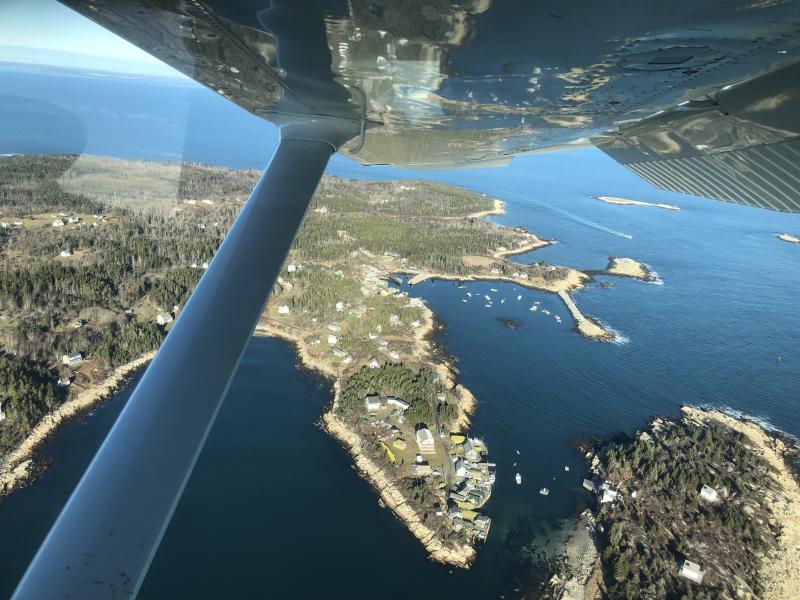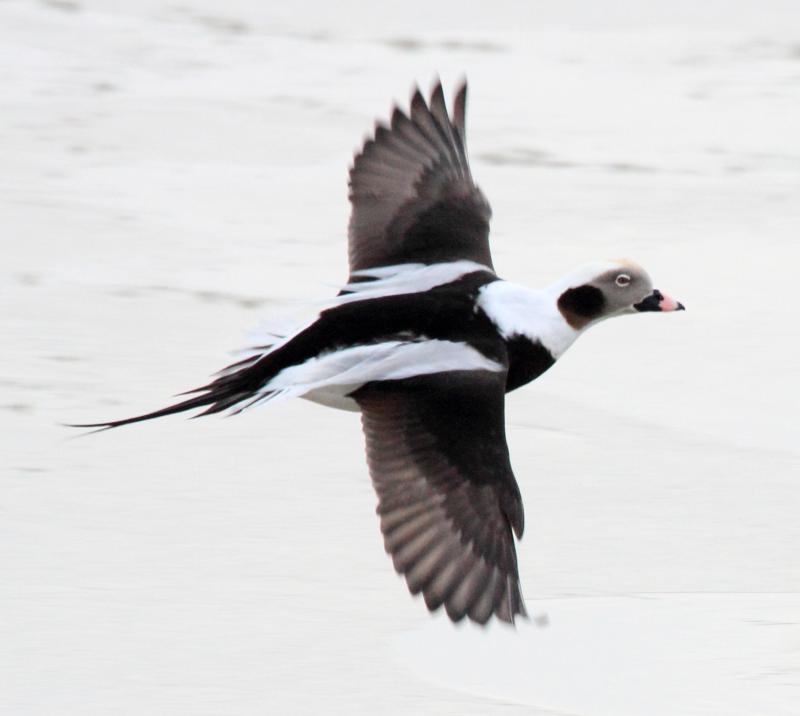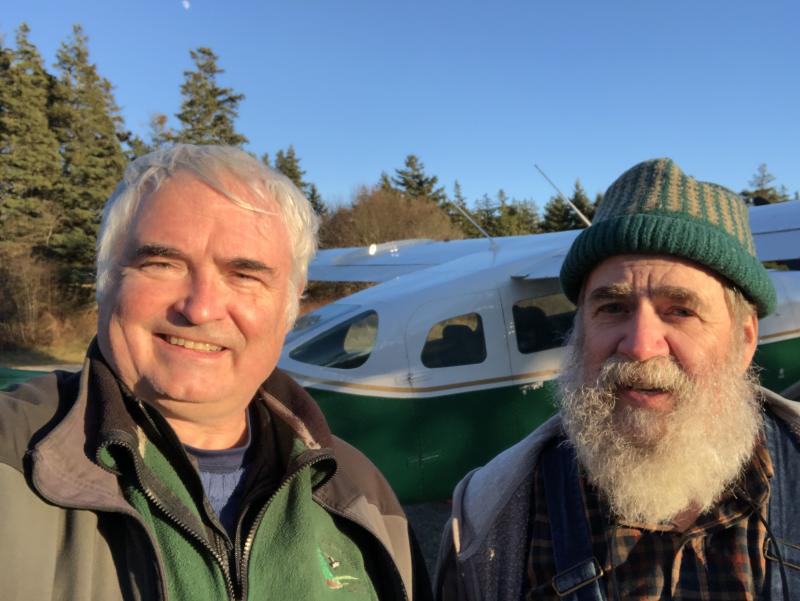A Warm Christmas Bird Count on Matinicus Island
 The view from the air of the harbor on Matinicus Island, where the author conducted a recent National Audubon Christmas Bird Count. Courtesy of Jeff Wells.
The view from the air of the harbor on Matinicus Island, where the author conducted a recent National Audubon Christmas Bird Count. Courtesy of Jeff Wells.
 Stunning long-tailed ducks were seen in good numbers around Matinicus Island on the Audubon Christmas Bird Count on Jan. 2, 2023. Photo by Dominic Sherony courtesy of Wikimedia Commons.
Stunning long-tailed ducks were seen in good numbers around Matinicus Island on the Audubon Christmas Bird Count on Jan. 2, 2023. Photo by Dominic Sherony courtesy of Wikimedia Commons.
 The author, left, was joined by island resident and friend Paul Murray for the count. Courtesy of Jeff Wells
The author, left, was joined by island resident and friend Paul Murray for the count. Courtesy of Jeff Wells
 The view from the air of the harbor on Matinicus Island, where the author conducted a recent National Audubon Christmas Bird Count. Courtesy of Jeff Wells.
The view from the air of the harbor on Matinicus Island, where the author conducted a recent National Audubon Christmas Bird Count. Courtesy of Jeff Wells.
 Stunning long-tailed ducks were seen in good numbers around Matinicus Island on the Audubon Christmas Bird Count on Jan. 2, 2023. Photo by Dominic Sherony courtesy of Wikimedia Commons.
Stunning long-tailed ducks were seen in good numbers around Matinicus Island on the Audubon Christmas Bird Count on Jan. 2, 2023. Photo by Dominic Sherony courtesy of Wikimedia Commons.
 The author, left, was joined by island resident and friend Paul Murray for the count. Courtesy of Jeff Wells
The author, left, was joined by island resident and friend Paul Murray for the count. Courtesy of Jeff Wells
This week’s column is provided from Jeff’s perspective following his trip to Matinicus Island.
The Audubon Christmas Bird Count (CBC) on Matinicus Island reached its almost consecutive 17th year this year, having been started by yours truly in 2005. I say “almost” because we skipped a year in 2021 due to COVID. Usually, I am joined by at least a couple of die-hard birders from the mainland for the short flight from the airport at Owls Head (near Rockland) over to the dirt landing strip among the spruces on the north end of Matinicus.
But this year, last-minute health issues caused my intrepid would-be fellow CBCer had to withdraw, which meant there were no other mainland birders joining me this year. After the short flight over the bay with two lobstermen who were flying to the island and then taking their boat back to the mainland, I scrambled my way out of the little plane and found long-time island resident Paul Murray beside the runway. Paul offered up the latest bird and people news from the island, a ride if I needed it, and some great birding companionship for part of the day.
If you don’t remember from previous columns, Audubon Christmas Bird Counts are bird surveys that take place within a prescribed 15-mile diameter circle between mid-December and early January. The first ones began more than a hundred years ago; now there are thousands that occur across the Americas, with tens of thousands of birder participants.
Unlike most years, when a heavy down coat is called for, this year on the count it was so warm I needed only a light coat, a baseball cap, and no gloves or mittens for most of the day. The walking was easy as there was no snow or ice. The little ponds and swampy areas were all open. If any of the introduced ring-necked pheasants or turkeys that we found in the early years of the count had still been around, they would have found the conditions very survivable. Most years, they don’t, and we hadn’t seen either species for some years.
Over the 17 years that the count has taken place, the total number of species found has varied from a low of 34 to a high of 49. Ironically enough, that high number came on the first year of the count, when there were five of us participating and we were able to split up and cover more territory than in years since. Paul and I were pleased with our grand total of 40 species this year, which seemed in the ballpark of what might have been expected.
Common eiders were scarce—we counted only 37—compared to the early years of the count when we sometimes had several hundred. On the other hand, long-tailed ducks were relatively numerous—we counted 65. Interestingly, we had the highest number of common loons ever recorded for this count, with 22, and the second highest for red-necked grebe (21).
As usual, there were some oddities on the island, mostly lingering birds that occur earlier in the fall but are usually gone by early winter. Two species were completely new for the count—an eastern bluebird bopping from treetop to treetop down on the south end of the island, and an American kestrel hovering in place on rapidly beating wings over the small Ten Pound Island just offshore. A tiny ruby-crowned kinglet showed itself at the corner just beyond the school. A Lincoln’s sparrow popped in some bushes beside a pond not far from the airstrip, and a swamp sparrow in another spot. We tallied at least four winter wrens, and also a single red-bellied woodpecker—a species not found in the early years of the count but now found about every year.
The plane ride back to the mainland in the late afternoon light, looking out over Vinalhaven, North Haven, and the other islands of the bay, was stunning as always. More so perhaps because it felt like an accomplishment to have done our best to count the winter birds of Matinicus Island and contribute to furthering our understanding of the birds of Maine.
Jeffrey V. Wells, Ph.D., is a Fellow of the Cornell Lab of Ornithology and Vice President of Boreal Conservation for National Audubon. Dr. Wells is one of the nation's leading bird experts and conservation biologists and author of the “Birder’s Conservation Handbook.” His grandfather, the late John Chase, was a columnist for the Boothbay Register for many years. Allison Childs Wells, formerly of the Cornell Lab of Ornithology, is a senior director at the Natural Resources Council of Maine, a nonprofit membership organization working statewide to protect the nature of Maine. Both are widely published natural history writers and are the authors of the popular books, “Maine’s Favorite Birds” (Tilbury House) and “Birds of Aruba, Bonaire, and Curaçao: A Site and Field Guide,” (Cornell University Press).
























